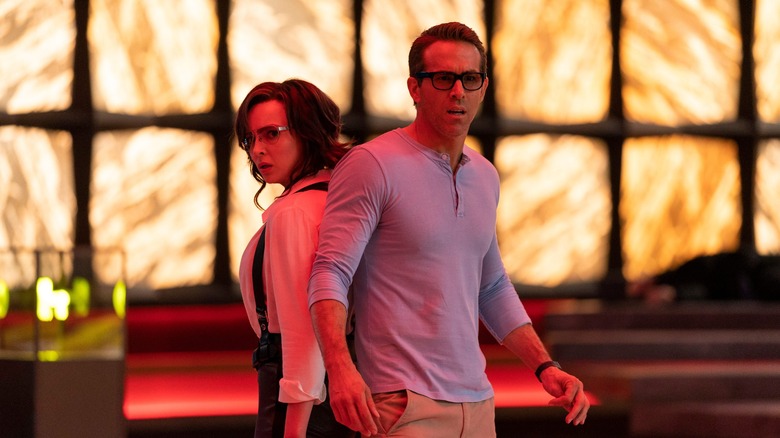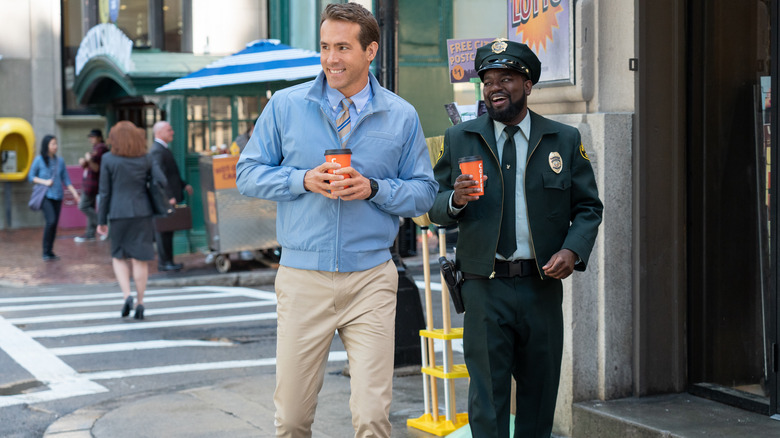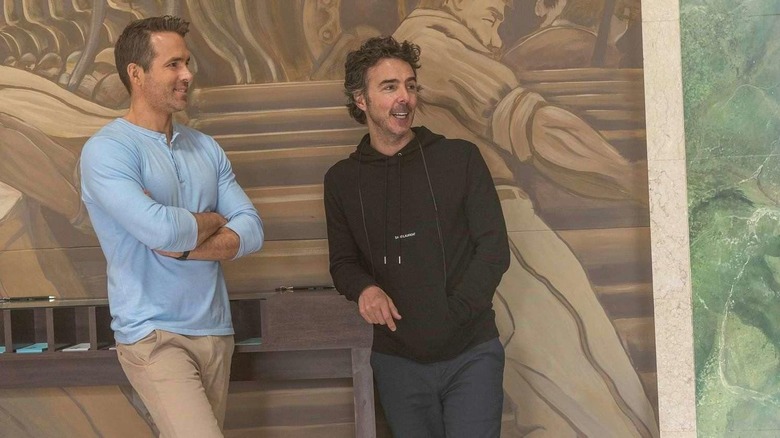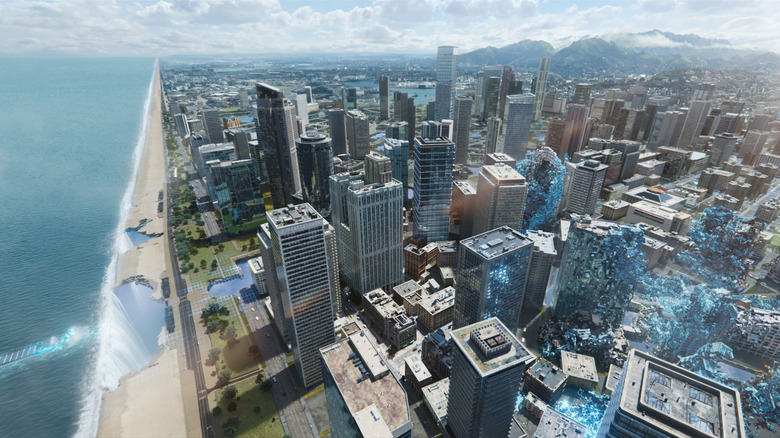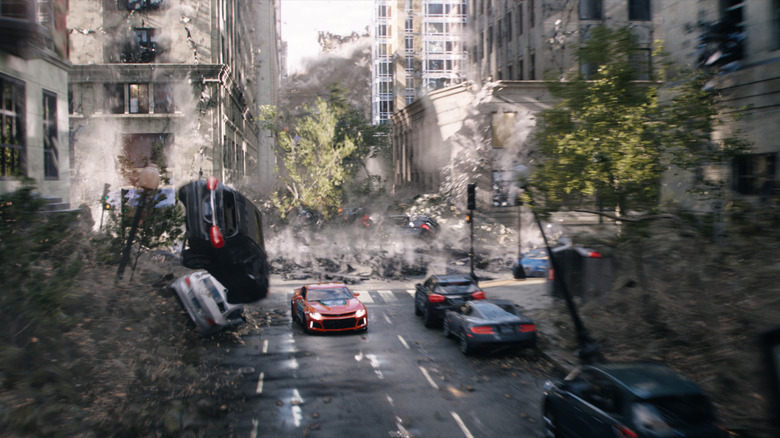Free Guy VFX Team On Their 25 Years Of Experience, Film Vs Digital, And Crafting That Opening Oner [Interview]
"Don't have a good day ... have a great day."
Somehow, that endlessly repeated catchphrase actually sounds kind of sincere in "Free Guy" when delivered by Ryan Reynolds, who plays the hopelessly naïve video game NPC (non-player character) named, fittingly, Guy. But no movie star-caliber acting was necessary to convince me that the VFX crew behind the movie were as tightknit and refreshingly frank as they appeared to be during the breadth of our conversation when I interviewed them recently. Ahead of the film's streaming debut on Disney+ in just a few weeks, I had the pleasure to talk to longtime VFX Supervisor Swen Gillberg ("Avengers: Endgame," "Avengers: Infinity War," "Furious 7," "Real Steel," "Pirates of the Caribbean: At World's End"), who /Film's Jack Giroux also interviewed in 2021. Joining Gillberg in our conversation was VFX Supervisor Bryan Grill ("X-Men: Dark Phoenix," "Black Panther," "Independence Day: Resurgence," "Pirates of the Caribbean: At World's End") of Scanline and VFX Supervisor Nikos Kalaitzidis ("Shazam!," "The Curse of La Llorona," "Shadow," "The Fate of the Furious") of Digital Domain.
The trio have worked together on various projects for well over two decades now, and that familiarity certainly shows. Not only did that inevitably lead to a better and smoother working environment during production of "Free Guy," but it also resulted in as entertaining a discussion as I could possibly ask for. Throughout the course of our conversation, we talked about whether a movie as complex as "Free Guy" could've been made even a few short years ago, the differences between VFX work on film as opposed to digital, and the process of constantly adding more "oomph" to the ambitious one-shot sequence that opens the film.
"It Just Becomes One Big Family after a While"
To state the obvious, all three of you have extensive experience in this field. How crucial was having that established background when working on a movie as CGI heavy as "Free Guy"?3
Swen Gillberg: Just like anything in the world, I think the more experience you have, the better you're going to be at it. So, and we've all been working together, literally working together for 25 years. So [laughs] it really helps to have that extensive knowledge, but I mean, it's good for doctors too and anyone else, but yeah. No, it's great to have a good team and a lot of history and a lot of knowledge.
Nikos Kalaitzidis: Yeah. And even with those 25 years, we're always learning something new. There's no question about it. Like, oh, and every show, you bring to the next show what you just learned just in the last one, and it's always a learning experience. It always helps you, what we've done in the past to bring to the plate right now, currently on whatever show that you're working on. And yeah, doing visual effects in general, I think it definitely helps with what we do.
Bryan Grill: I was just going to say the beauty of knowing each other, when we were just starting out and the growing pains and then actually just being friends and meeting your wife and having kids and just kind of growing old together and talking to each other. All that life experience definitely, it plays a big part in our work experience because work is a big part of our lives. Visual effects, there's not a 9-to-5 job. So your family ends up being your coworkers or you meet your family or make your family from coworkers [laughs]. So it's a blessing.
Kalaitzidis: Well, just because we're doing this 24/7, it just becomes one big family after a while.
Gillberg: I believe that all three of us at one time or another in the last 25 years have shared an office, which means we spent 18 hours a day in the same room [laughs].
Grill: And then went to, after office hours, spent another three or four... having drinks and talking about it.
Kalaitzidis: As a matter of fact, after this interview, we're probably going. Kidding. [Laughs]
"We're Here to Help Take Care of His Vision"
In terms of both your ability and the tech available to you, do you think you could have done a movie like this even five years ago? Or is it a movie that you could have only made when you did it? Is that how complicated it is?
Gillberg: I think that the computers keep getting, so the render times are getting better. I think we could done a lot of it, it would just would've taken a lot, lot longer. Also back in the day ... we used to shoot everything on film and [laughs] we'd literally film everything out and I can't believe we did this, but we wouldn't be able to see the shots, so we would send them to film overnight and then we look at them in the screening room the next morning. So if you just think about the turnaround time there is just horrendous compared to now, you render it and look at it in 10 minutes. So I think we could have done most of it, but it would've taken 10 times longer.
Grill: I mean, I think it's story. If the story needs a certain look and the director is trying to tell a story, we're going to make that happen. And I think that's the most important part of the visual effects, is maybe they're not the latest and greatest, but they serve the story and they help people enjoy themselves. I think that's, knowing how to put the two together and make it work, I mean, that's the technology right there.
Swen, I know you've worked with [director Shawn Levy] before on "Night At The Museum" and "Real Steel." Having that working relationship with him and bringing that to "Free Guy," how much did that help you while collaborating with him in general?
Gillberg: That's huge. I mean, just having a shorthand and a certain level of confidence with each other, it's massive. I really love working for Shawn. I hope to be working with him shortly.
Can you tell when a director comes in and he doesn't have that preexisting, baseline knowledge of the effects?
Gillberg: Yeah, absolutely. Sometimes there's a bit of a learning curve. Even with Shawn, he doesn't actually always ... he knows what we want, but doesn't know how we do it. And so, but he doesn't need to, that's our job. So we're here to help take care of his vision. He just tells us what his vision is and then we figure out how to do it.
"We've All Learned to Just Help Each Other Out Rather Than Compete"
Bryan and Nikos, can you speak to how both Scanline and Digital Domain split up the visual effects you sequenced for this movie?
Grill: So we both worked on Free City, creating the city in some shots and [Scanline's] were more of a wider scope. And a lot of the work that Nikos [and Digital Domain] did was the gameplay, which needed some of that scope. And so there was definitely a transference of assets, but again, the cool thing was the gameplay didn't need to be exactly 100% pixel for pixel, the same look. It just needed to feel, and I think that goes for some of the other vendors as well. There was a lot of sharing in order for all the pieces to come together. And then on top of that, it would go to another vendor who either put the graphics on top of all the work we did, or for Dude, they would put Ryan Reynold's face on top of comps at another vendor. So I kind of feel like, especially on set, we both knew what we needed to get. And if Nikos needed something, I was like, "Oh yeah, I shot this." And then he can ask where those plates were or whatever.
If you thought saving the day in Free Guy was hard, imagine the effort involved in putting together this sequence. Get a look at how those visual effects came to life, courtesy of @20thcentury and @DigitalDomainDD. pic.twitter.com/BCksiaZZf7
— /Film (@slashfilm) January 26, 2022
Kalaitzidis: It was definitely a collaboration. It was a great collaboration. There was one point where even Bryan and myself in Boston, Swen is looking at a shot, he wasn't sure who's it going to go to, and Bryan and I were literally arm wrestling saying, well, "I could do it." "No, I could do it." "No, I could do it." [Laughs] Remember that? It was by the beach there. And so I feel like in today's world, in visual effects, the climate and landscape has changed quite a bit. Feels like maybe a decade ago, we were really competing against each other. And right now it's more of a collaboration, because as you mentioned earlier, Jeremy, can we do these, how would we have done these movies, like a decade, five years ago? And now it's because there's so much work and there's so much volume of work and the volume of work needs to have a really high level of quality and fidelity that we've all learned to let's just help each other out rather than compete with each other. And if Bryan needed a face on Ryan Reynolds or a gameplay shot, I'd help him out. If I needed some sort of geometry that he's doing in effects and export it out so I could render it in gameplay, he helped me out there. And it just feels like it's a different climate today with all the vendors that we're dealing with for any of the movies compared to what we had to do five to ten years ago.
Grill: Agreed. Yeah. The bar is high and I think if we're all going to reach that bar, we definitely have to work together. That's for sure.
Kalaitzidis: Yeah, totally. So it's not just Swen dealing with the vendors [laughs], I feel like we have to reach over to the vendors and help ourselves help each other. Yeah.
Gillberg: And the climate has changed. It's an amazing amount of work that's expected to be done with all the streaming shows that are going on right now. So all the vendors, not just vendors, all my people, it is busy right now. So it's, yeah. Working together helps. And like Bryan said, the bar is high. No one wants to or is allowed to do bad visual effects [laughs] pretty much.
Grills: Want to, we do not want to [laughs].
"I Think This Shot Needs a Pterodactyl. And We Put a Pterodactyl In"
A movie like "Free Guy," it's obviously heavily influenced by video games. Does that change your process at all? Because the special effects don't necessarily have to be photorealistic or naturalistic. So is there a weird balance? Is it a little counterintuitive where you almost have to fight against your instinct to make it as photorealistic as possible? I'm curious how that works.
Gillberg: I think our goal is always to try to make it as photo realistic and roughly apply to gravity, physics, that kind of thing. But the beauty of it was just ... no rules. Whereas if you're in a superhero movie, you can only fly or whatever, it was just like anything goes. And that was a really fun part of post was, "You know what I think this shot needs? I think this needs a pterodactyl. What do you think?" And we put a pterodactyl in [laughs]. And that was a very unique and fun part of this one, whereas other ones have very set rules kind of thing.
What was the most difficult sequence or even just a single shot to render for "Free Guy"?
Kalaitzidis: Yeah, I have favorite shots and there's also the most challenging shots. And sometimes they're both. In this particular case, the most challenging shot would definitely have been the badass opener in the opening scene, which really sets the stage of what Free City should be and the sort of style andwhat to expect for the rest of the movie. It was really a blueprint of what that movie was. And it was over 3000 frames. We had it as one single shot and from beginning to end and the timing of it from the beginning, anywhere in the middle would always affect the end. But the funny thing about that one shot is that when, I mean, Swen actually pre-vised it from months before we actually went ahead and shot it. And after we shot it, and after we looked at it and we put it together for the first time, the first comp, we put it together, showed it to Swen, showed to the clients and ... what an accomplishment to get there finally, after so much prep. And we looked at it and we're like, "Huh, it just doesn't have enough oomph." And so that's when we've learned that, "Okay, let's rip off the band-aid and let's just throw everything into it to, what does it take to just to make it a lot more fun?" And so that's when we just started discovering, it's like "Let's have a helicopter blowing up, let's have a helicopter chasing this guy, let's have the motorcycle crash and let's have a bank truck with money blowing out of the end. Just, let's have one explosion, two explosion and not enough explosions, put another explosion in there." So it was always something that we had to try to come up with ideas to make it funny and entertaining as this 3000-shot was moving forward. So that was a good challenge.
Thanks to @20thcentury, check out a behind-the-scenes look at the Free Guy sequence that posed one of the greatest challenges for the VFX crew: the "Street Squeeze" scene, created by @Scanline_VFX . pic.twitter.com/cT7tpLPvkK
— /Film (@slashfilm) January 26, 2022
Grill: For us, the street squeeze sequence was a challenge because we ended up, because of the buildings moving and you're in a city and the sun is hitting windows and there's reflections and then there's bounce, and so because the buildings were moving, everything needed to react and coexist. Because the lighting's changing. And so we literally, over the course of the sequence, had to pretty much render every shot in camera, so to speak. And then we would use deeps to kind of take it apart and then put it back together in compositing. But we needed to make sure that it was physically correct, lighting-wise and making sure that when everything interacted with each other, it was getting the proper lighting throughout. So, usually it's an all-CG movie like you would see that's rendered all in camera. So this was a big thing because that takes a lot of time and machine power to do that, where usually you can just render separate elements and then you just put it together. Didn't work like that this time [laughs].
